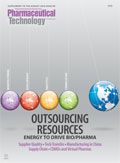Dealing with Pharmaceutical Supply-Chain Complexities
Planning ahead is key to enabling a continuous and secure supply chain that adapts to changes in market demand.
Image Courtesy of Vetter Pharma InternatIonal GmbH

In an era of globalization, international pharmaceutical and biotech industries are faced with continuous market change, intensifying competition, cost pressures, and increasing regulatory requirements. Advances in research and development drive specialization and differentiation of individual drugs as the bandwidth and number of products continues to grow. Additionally, the demand in the pharmaceutical market is subject to high fluctuations. Even attempts by researchers to predict demand using advanced statistical tools have failed to produce accurate results. This changing market environment also affects operations of contract manufacturers due to a growing demand for drugs manufactured in smaller annual volumes, increasing customer service levels (CSL), and reduced lead times.
All of these factors have an impact on the complexity of today’s pharmaceutical supply chain. Service providers have to accept changes in market demand and adapt to the circumstances accordingly. The aim is to achieve high machine utilization with effective overall equipment efficiency (OEE). Experienced contract development and manufacturing organizations (CDMOs) offer answers to the challenging supply chain and deliver high product quality. But can an agile supply-chain management be achieved in this environment?
Coordination and cooperation
The first step in establishing an efficient supply chain is open communication between all stakeholders, such as the drug manufacturer, the service provider, and the suppliers. This open communication from the start will strengthen the relationships through a common understanding of the other parties’ expectations, making it possible to overcome roadblocks and challenges that could disrupt both operations and the partnership. Processes such as demand exchange, cut-off times for purchase orders, and fixed production zone, among others, can be handled through a supply agreement between the biopharmaceutical company and the CDMO. Defining certain key performance indicators (KPIs) to jointly measure the supply chain performance on a monthly basis will also help to avoid misunderstandings due to different targets. Regular consultations in the form of business review meetings or customer sales and operations planning process (S&OP) meetings allow for a highly focused view of the situation and, therefore, early identification of changing circumstances.
CDMOs are making increased use of the S&OP as a key supply chain process. Monthly reviews of the demand and supply situation and making the necessary decisions are key factors for an agile supply chain. The internal target is a high OEE (to maximize machine utilization), while the external target is a high customer service level (to fulfill customer request). A functional S&OP process helps balance out any conflicts between these two targets. Close coordination between drug manufacturers and the service provider is essential in both the short and long term to react quickly to any need for changes in manufacturing.
Due to the demand fluctuations noted, it is best to think in scenarios (minimum, base, and maximum) when defining capacities for the upcoming months. However, optimized planning processes demand certain preconditions in production to facilitate flexibility in areas of technology, processes, and human resources.
Versatile resources
Whether it’s a sudden increase in demand or decrease in available API, the ability to adapt to the needs of the market is crucial. To be able to allocate resources according to real-time demands, final planning (e.g., for cleanroom capacity utilization) must be done weeks before production. Realizing such high flexibility indicates the use of multi-product lines featuring modular equipment. Having already established and validated equipment and processes in place is an additional advantage of being able to manufacture one product on different lines. Many biopharmaceutical companies are in favor of qualifying two different cleanrooms at the same service provider when security of supply is absolutely crucial, or in the case where a second supply site does not exist. Short paths between the storage facilities and production sites are also beneficial for an agile supply chain.
The area of human resources is also of great importance. Employees cannot maintain their focus only on specific jobs, but must be trained as well in handling different tasks within the manufacturing process. This approach allows a company to use its staff at short notice in other work areas where there may be a greater capacity gap. For a contract manufacturer in fill and finish, for example, this model applies to either the filling process or the department of visual inspection. Such an approach can avoid potential bottlenecks in the production process.
Managing storage capacities and stock
The volatility of growing demand is also having a strong impact on the storage capacities of CDMOs. In addition, the number of APIs that are deep-frozen as well as finished products that must be kept at 2-8 °C is also growing. Because shelf life is crucial to customers, the cold chain needs to be maintained throughout the entire production process to uphold the quality of many sensitive substances. Providing comprehensive in-house storage capacity, including a variety of different temperature areas, is the preferred way of meeting virtually any requirements for APIs, ingredients, and final products. Demand variations can be buffered.
Production can only react to unforeseen demand changes if inventory is available and accessible in the short term. This issue is one of the fundamental differences between the pharmaceutical industry and other industries. In the area of fill and finish of injectables, the following stock is usually in storage for production:
- API
- Primary packaging material (e.g., glass barrels and stoppers)
- Secondary packaging material (e.g., foils, cardboard packaging)
- Semi-finished goods (e.g., filled syringes waiting for final quality control or release).
Fluctuations in demand and increased regulatory requirements often challenge the proper adjustment of inventory for an in-time production process. The rule of thumb is that inventories of forecast-stable products (+/-10% of customer forecast) should ideally be driven down, while those of forecast-unstable products (over +/-10% of customer forecast) should be increased. At the end of the process, the stock of dispatched goods, for example, released syringes waiting for pick-up transport, must be maintained and stored properly in the warehouse regardless of whether it is ambient or cold storage.
Conclusion
The process of globalization will continue to lead to the opening of additional markets, each of which must be addressed and served according to its specific demands. Further, the number of drugs will continue to increase in coming years, as will the complexity of supply chains. Both biopharmaceutical companies and their contract manufacturing partners must be prepared to face these challenges. There is a clear need to further improve upon open communication in a sharing, demanding scenario. It will take efficient processes such as S&OP to achieve the desired flexibility while maintaining high quality and safety standards for the products. Real-time planning and the possibility to adapt capacity to react flexibly to changes in demand will be the key to an agile CDMO supply chain.
Article Details
Pharmaceutical Technology Outsourcing Resources Supplement
Pages: s28–s29, s56
Citation:
When referring to this article, please cite it as M. Schmitz “Dealing with Pharmaceutical Supply-Chain Complexities," Pharmaceutical Technology Outsourcing Resources Supplement 2016.

Pharmaceutical Tariffs Are Imminent: How Industry is Bracing for Impact
April 16th 2025On April 14, 2025, the Trump Administration launched a national security-driven investigation into pharmaceuticals, a move that will likely result in tariffs being placed on pharmaceutical drugs, ingredients, and other components that are imported from outside of the United States.
Drug Solutions Podcast: A Closer Look at mRNA in Oncology and Vaccines
April 30th 2024In this episode fo the Drug Solutions Podcast, etherna’s vice-president of Technology and Innovation, Stefaan De Koker, discusses the merits and challenges of using mRNA as the foundation for therapeutics in oncology as well as for vaccines.